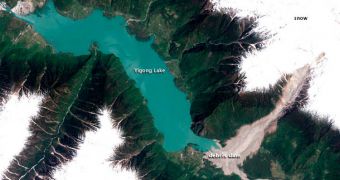Back in 2000, the world witnessed one of largest, most impressive landslides ever recorded. The event took place in eastern Tibet, and poured massive amounts of rocks, soils and other debris straight into the Yigong River, blocking it.
The natural dam prevented the river from flowing as usual for more than two months, and led to the creation of a huge lake behind the obstruction. It is currently estimated that the landslide put 100 million cubic meters (3.5 billion cubic feet) of debris into the natural dam.
The landslide occurred on April 9, 2000, and it took it only 10 minutes to completely block the river, as shown in the image to the left. Loose rocks, soils, vegetation, granite, marble and ice were mingled together into an impassible barrier.
All of the 100 million cubic meters of material traveled 10 kilometers (6 miles) in length and 5,520 meters (18,110 feet) in elevation in these 10 minutes. The steep gorge that channeled its movements ends at 2,190 meters (7,185 feet) above sea level.
According to researchers, rainfall and meltwater that had previously infiltrated those soils enabled the landslide to catch on speed. At its fastest, the dislocated material traveled at a speed of 14 meters per second (31 miles per hour).
It took a longer time for the debris to come to a halt. By the time this happened, the natural dam it had formed spanned an area of 2.5 square kilometers (1 square mile), and was around 90 meters (295 feet) high. Yigong river waters could not penetrate it, so they began to accumulate behind it.
Over time, the waters did manage to infiltrate the base of the dam, but only in small amounts, sufficient to muddy the course of the river downstream from the natural obstacle. At the same time, the lake continued to grow.
“As it did, authorities evacuated thousands of people from villages downriver and started digging a channel through the debris in the hopes of slowly draining the lake. The channel was finished by June 3, 2000, but it wasn’t enough to stop the dam from collapsing catastrophically on June 11,” NASA says.
“The collapse sent a massive surge of water down the Yigong that swelled it up to five times its normal width. Floodwaters in the wake of the collapse destroyed five bridges, sections of a highway, and communications cables along the banks. The flooding proved most destructive downriver in India where it destroyed the homes of 500,000 people,” the agency concludes.

 14 DAY TRIAL //
14 DAY TRIAL //